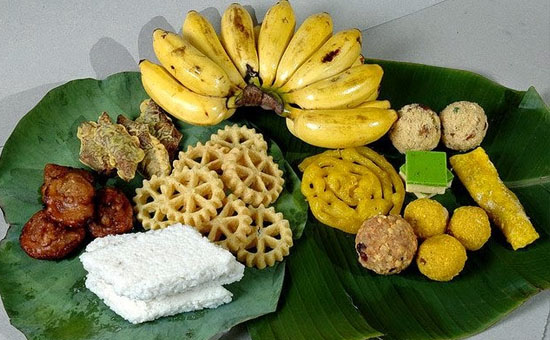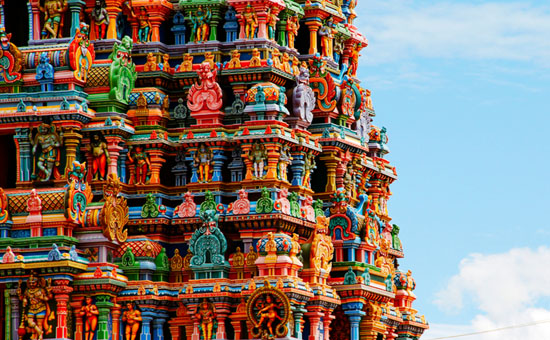The Tamil ‘Puthandu’ (New Year) marks the beginning of the Hindu solar calendar and the first Tamil month of ‘Chithirai’. It is believed that Lord Brahma, the supreme creator, began creation on this day.
Puthandu, also known as “Puthuvarsham” and “Varsha Pirappu”, is celebrated in Tamil Nadu and Pondicherry. Falling on April 14th, the Tamil New Year coincides with festivities in other parts of the country – ‘Vishu’ in Kerala, ‘Baisakhi’ in Punjab, ‘Poila Boishak’ in West Bengal, ‘Pana Sankranti’ in Odisha and ‘Rongali Bihu’ in Assam. Interestingly, this day is also celebrated as the start of the New Year in Nepal, Sri Lanka, Laos, Cambodia (Khmer New Year) and Thailand (‘Songkran’). The festival is also celebrated in countries like Malaysia and Singapore, which are home to a sizeable population of Tamil origin.
As
per the 60-year historic Hindu calendar cycle, April 14th of this year, heralds the arrival of ‘Vilambi Samvatsara’.
Like most festivals in India, the Tamil New Year too is not just a celebration of all the five senses – sight, sound, taste, touch and olfactory – but a reinforcement of age-old customs and traditions that transcend the material, moving onto a sublime experience of the spiritual.
Colourful rice-flour ‘kolams’ (‘rangoli’ designs) dot entrances to homes, wherein families gather to celebrate this special day with piety and fervour. In some parts of Tamil Nadu, the day begins with the viewing of the auspicious sight of a decorated tray filled with seasonal fruits – especially, mangoes and jackfruits, flowers, betel leaves and areca nuts, coconuts, gold & silver coins, money and jewellery (similar to ‘Vishu Kanni’ in Kerala). Younger members of the family have to keep their eyes closed and are led by the elders to view this decorated tray, first thing in the morning. Touching the feet of elders to seek their blessings, younger members receive gifts from them, usually in the form of cash.
This
tradition of decorating a platter of fresh fruits and vegetables along with
other symbols of prosperity, is in many ways, a remnant of a predominantly
agrarian era of the past and symbolises gratitude shown to the divine for the
all the bounties of a good harvest.
New clothes are worn on this occasion and fruits and sweets are offered to deities at home after the traditional ‘pooja’. ‘Tarpana’ is also performed for ‘pitrs’ (ancestors) on this auspicious day. People visit temples during the day to pray and seek blessings for a successful and prosperous year ahead.
The highlight of the festival is the elaborate feast which blends in the different flavours – sweet (jaggery), sour (mango) and bitter (neem flowers), much like a microcosm of the different shades of life.
 Foods and Sweets
Foods and Sweets
The ‘mangai pachadi’ (a sweet and sour mango dish) and ‘veppanbu pachadi’ (made of neem flowers, tamarind, jaggery and sometimes with mangoes added) are must-haves on the menu. Other important items include the ‘kosambari salad’ made with split green gram (moong dal), ‘vadas’ which are fried savoury snacks, ‘payasam’ made with milk and lentils and sweet ‘poli’ (made of flour stuffed with split chickpeas, jaggery and coconut) akin to ‘puran polis’, a popular Maharashtrian sweet dish.
Preparing and partaking of this feast epitomises unity and sharing of the varied hues and flavours of life, with one’s family and friends.
Many temples across Tamil Nadu perform special ‘abhishekams’ to deities on this day. In earlier times, the ‘panchangam’ (Hindu calendar) for the New Year would be read out aloud by the priest at the temple, for the benefit of all the devotees. These ‘panchangams’ include predictions regarding key aspects of the forthcoming year impacting everybody such as the quantum of rainfall – a crucial factor for agricultural prospects. Cooling drinks such as ‘panakam’ (usually made by dissolving jaggery in water with a dash of cardamom powder) and ‘neer mor’ (spiced buttermilk) are offered as ‘prasadam’ to devotees.
These days, ‘panchangams’ are increasingly read at homes, by elders of the family.
Temple festivals and grand ‘Ther’ (Car / ‘Rath’) processions are held during the first Tamil month of ‘Chithirai’, in various temples across Tamil Nadu. ‘Meenakshi Tirukalyanam’, the celestial wedding of Goddess Meenakshi with Lord Sundareswarar, is part of the renowned ‘Chithirai’ festival at the Meenakshi Amman temple in Madurai.
 Facade of the gopuram of the Meenakshi Temple Madurai
Facade of the gopuram of the Meenakshi Temple Madurai
‘Puthandu’ celebrations also offer the perfect platform for people to reconnect with traditional songs, dances and games. Women come together to perform folk dances such as ‘kummi’ and ‘kolattam’, as part of the festivities. In some places around Madurai, Tirunelveli and Tiruchirappalli, dances like ‘Oyilattam’ are performed narrating stories from the ‘Puranas’, especially about Lord Muruga.
 Kolattam, Kummi, Oyilattam dance
Kolattam, Kummi, Oyilattam dance
A festival of joy and oneness, the Tamil ‘Puthandu’ is the harbinger of new beginnings.
“Ellorkkum puthandu nalvazhtukal!”
References
1.
https://www.maduraimeenakshi.org/festivals.html
2.
http://www.indiamapped.com/folk-dance-in-india/tamil-nadu-oyilattam/
To see pictures
of
1. Meenakshi Temple Madurai
2. Murugan Temple Palani